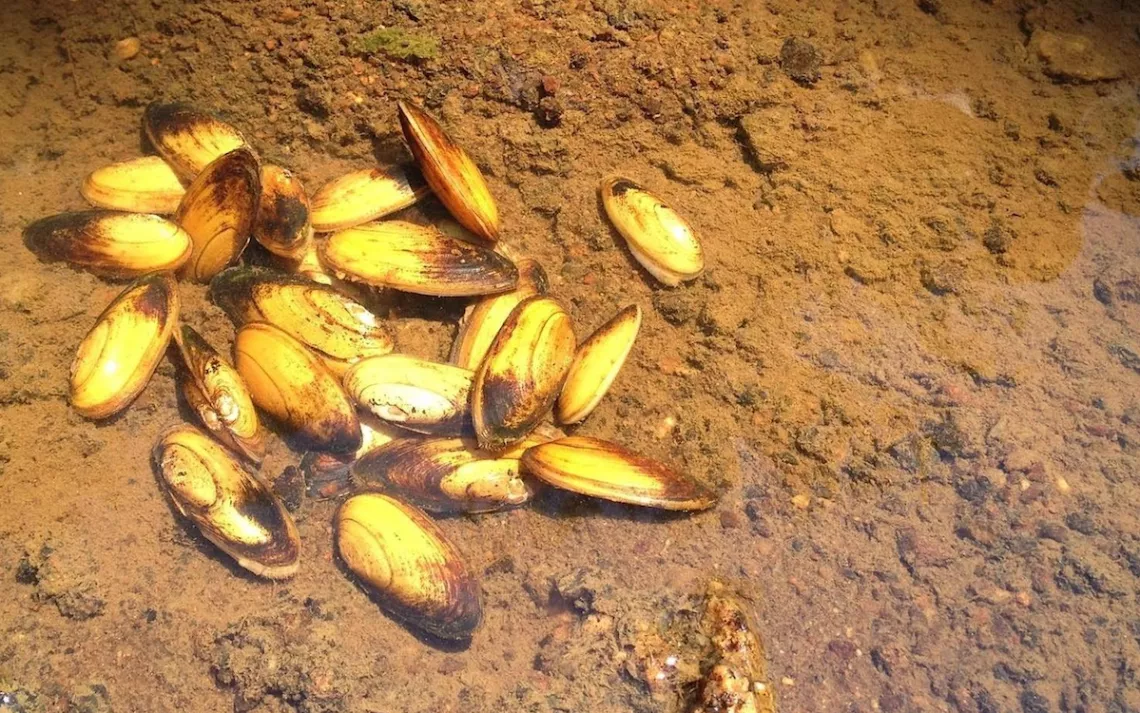Say Hi to America’s Newest Threatened Bivalve
Hates: Pollution. Loves: Hitch-hiking

Yellow lance mussels in the Tar River, North Carolina. Photo courtesy of Sarah McRae, USFWS.
It’s hard out there for a mussel: out of the almost 300 species of freshwater mussels in U.S. and Canada, more than 200 are listed as endangered or threatened. And on Monday, one more—the yellow lance mussel, found mostly in Maryland, North Carolina and Virginia — was added to the Endangered Species Act list of threatened animals. The decision, which will come into full effect on May 3, was a long time coming—the yellow lance was first considered for protection in 1991.
The yellow lance was once common enough that it was widely used to make jewelry and buttons, but industrialization has taken its toll. “Mussels are very sensitive to water pollution, so in areas that already have a lot of pollution, the mussels are probably already wiped out,” said Tierra Curry, a senior scientist with the Center of Biological Diversity.
The listing will make it harder for development to happen in what territory the yellow lance has left. “For proposed new projects that involve a federal permit or federal funding, the Fish and Wildlife Service could require the project to be modified to prevent harm to the mussels,” Curry told Sierra. “If there were mussels surviving downstream of an existing pollution source and it could be demonstrated that the pollution was harming them, then the company would be liable.” The listing also means that it is now illegal to “take” or harm, harass, kill, capture, or collect yellow lances.
Pete Benjamin, a North Carolina field supervisor for the U.S. Fish and Wildlife Service who has worked on conservation of mussels for a decade, says the mussels became threatened due to a number of different factors, including urbanization, agricultural runoff, a build up of sediment within stream systems, and water flow.
Yellow lances are a part of a class of marine and freshwater creatures called bivalvia, which includes, mussels, clams, cockles, oysters, and scallops. Like all freshwater mussels, they have an unusual life cycle—After fertilization a larva called a glochidium will attach itself to a host fish’s gills by a series of hooks. The fish will then swim to a place a mussel would not be able to travel to, distributing it to a new habitat in a river or stream where it can propagate.
Some mussels have very specific fish preferences, but Benjamin says yellow lances can choose a variety of fish hosts. They do, however, take a shine to white shiners, a silvery minnow-like fish, as their locomotive acolyte. Freshwater mussels can live for up to 100 years, and, like trees, they develop growth rings on their shells as they age.
Because adult mussels by nature are immobile, they are one of the few endangered creatures where human interference may be necessary to survive in different freshwater areas in the Southeast. Benjamin says there are facilities where yellow lances are being held for reintroductions to other watersheds in order to increase their numbers overall.
“With careful planning and identifying those areas where reintroductions would be appropriate to try, while focusing on habitat protection where populations already exist… we hope for good things,” he said.
Another advantage to protecting the yellow lance is that lots of species rely on clean water. “Freshwater mussels are North America’s most endangered group of animals, which tells us we have to take better care of our streams and rivers,” wrote Curry after the announcement of the listing. “Because the yellow lance is an indicator of water quality, protecting its habitat will directly benefit people, as well as other wildlife that rely on clean rivers.”
 The Magazine of The Sierra Club
The Magazine of The Sierra Club



